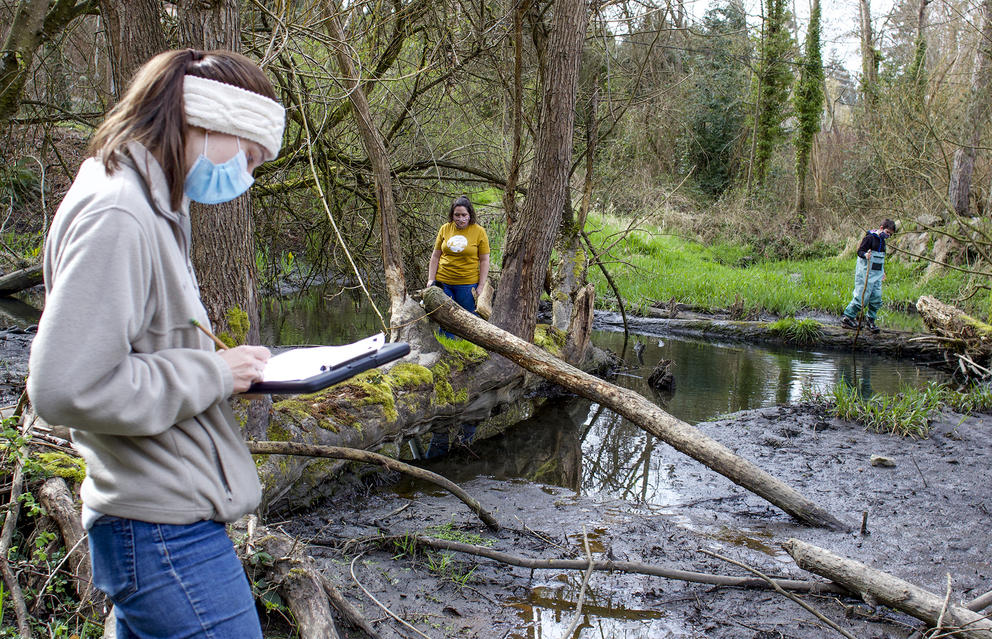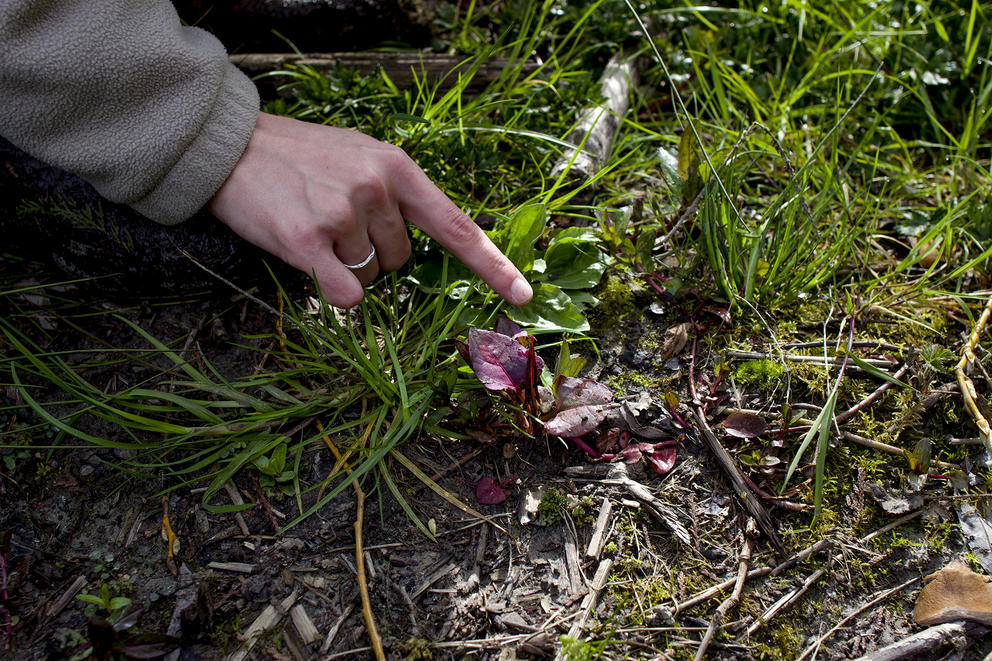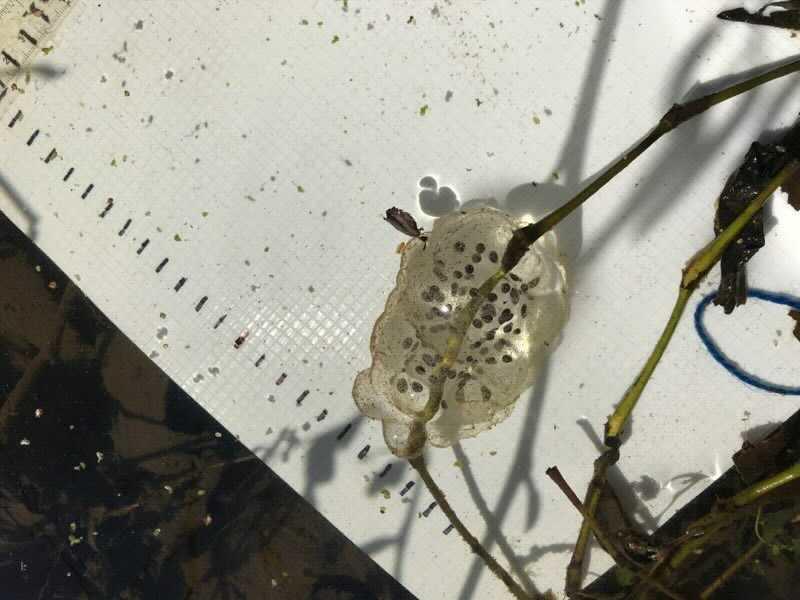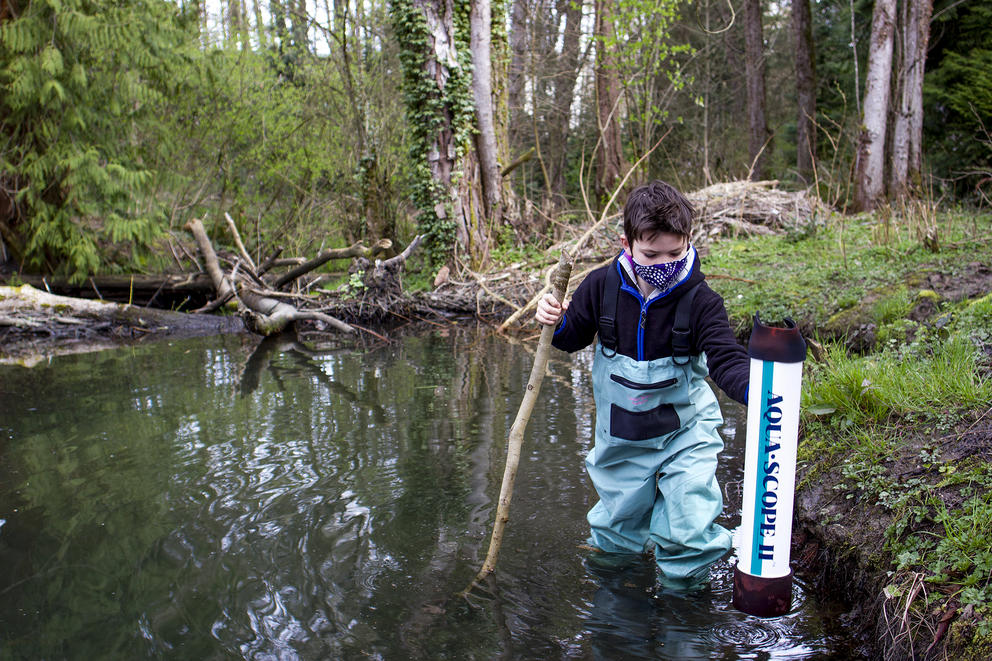Balancing at the far end of two free-moving logs in the middle of the Beaver Pond Natural Area on Thornton Creek in Seattle’s Northgate neighborhood, with a walking stick in hand, Tarroh has been checking the logs for amphibian egg sacs. Depending on the species, the translucent sacs range from gelatinous masses filled with tiny spheres, each punctuated with small black dots of embryos, to clutches of slightly slimy champagne grapes. With a consistency and tension similar to chicken egg whites, they would easily cling to the logs and branches surrounding Tarroh. His eggshell blue waders shuffle against each other as he pokes the logs with a stick to test their stability, edging past raccoon prints in the muddy banks. "I'm putting all my trust into that one year of gymnastics I took," he says.
Tarroh loves amphibians, partly for their resiliency: They can nearly freeze to death in winter but still thaw back out in spring, he points out. But since they're sensitive to changes in their habitat, even small environmental shifts can hurt them. "I feel like we've destroyed a lot of their habitat, so it's sort of the best we can do to help them survive and understand them and help," he says.
Tarroh, together with a group of five others, including his mom, Katrina Crawford, represents one of a handful of volunteer teams in the Woodland Park Zoo amphibian monitoring community science program. They’re on the lookout for the egg sacs of eight amphibian species to help track where amphibians are and where they’re breeding in Snohomish and King counties. The species are both common and rare, from the federally endangered Oregon spotted frog to the nonnative and invasive American Bullfrog.
“Amphibians, especially urban amphibians, are often so overlooked and can be such important indicators of what is going on with our environmental health and changing climate, as long as we are paying close enough attention year after year,” says program co-coordinator Katie Remine, the zoo’s Living Northwest Conservation coordinator.
The small teams that monitor each of the dozen or so sites go into the field once every two to four weeks during the pandemic while masked and distanced. Woodland Park Zoo averages 75 volunteers each year, Remine says; about 40% of them are returning volunteers. This particular team, says its volunteer team leader Maya Klem, visited its assigned site every two weeks since the beginning of February.
Even before the pandemic, community science programs filled huge gaps in the state’s ability to monitor highly sensitive, diverse species. Amphibians are already threatened by a host of things, including habitat loss and climate change. As those threats worsen, being able to keep track of the losses — or anticipate them in time to head them off — will become only more valuable.
Monitoring is more than a walk in the park
During each visit, the team travels clockwise around the perimeter of the site’s beaver-dammed pond, examining plants and roots hanging off into the water — places where the egg sacs (which can range in size from a pinhead to a golf ball) are most likely to adhere.
They use a survey protocol adapted from the Washington Department of Fish and Wildlife’s Oregon spotted frog surveys. “Protocols in other parts of the country rely on people reporting amphibian calls that they hear, but our salamanders and newts don’t make any noise,” Remine says. Volunteers log physical descriptions of the egg sacs, their GPS locations and other relevant information before taking photographs of them and submitting them to iNaturalist, a species identification database.
With Tarroh in waders deep in the water, everyone else serves as extra eyes. They carry a motley set of tools, both pedestrian and exotic. Christine Stephens carries a pencil and log sheet, while others tote aquascopes that help them see underwater through surface glare. Neon yellow skunk cabbage striped with early-spring morning sunlight surrounds them. “They’re a sign of spring,” says Klem, who has a skunk cabbage tattoo and spent her childhood looking for frogs, salamanders and other amphibians just north of Seattle.
Klem carries ropes in case they need to pull anyone out of the pond’s deep muck. "They're still in the plastic — in fact I don't think they've ever been used by anyone in the program," she says. Everyone else laughs and knocks on nearby trees for luck.
Volunteers crawl under downed branches, over slippery rocks, and become intimately acquainted with which mud pits to avoid if they want to come out with their waders still attached. “There’s a certain Lord of the Rings-ness to it,” says outdoors writer Diane Rudholm, slogging through the mud.
Sarah Portugal, a first-year program volunteer who is studying biology in college, likes doing hands-on work in nature. “Most of what I've done has been more in a controlled setting,” Portugal says. “I think this is more unexpected — you go in not really knowing what you're gonna find."
"It's just nice to [be involved in] something that's community oriented and accessible to everyone," Rudholm says. "It can be sort of easy to feel helpless about environmental stuff ... [and] it's just something manageable that I feel like we can do."
That community work is essential to keeping tabs on Washington wildlife. State Department of Fish and Wildlife employees like district wildlife biologist Chris Anderson say the department doesn’t have the budget or personnel to monitor all species. Resources are focused on vulnerable and declining species, like the Oregon spotted frog, which is no longer seen in King County but has small populations elsewhere in the state.
“If we did not have programs like [Woodland Park Zoo’s], there would essentially be little to no data on such common species other than, perhaps, smaller efforts or personal data of folks [who have] interest,” Anderson says.
The Woodland Park Zoo’s Remine says that prior to the start of this program, Fish and Wildlife had few verified observational records of either common or rare amphibian species, particularly in urban and suburban areas. Since the zoo started the program in 2012, volunteers have contributed about 1,876 observations. Volunteers contributed 104 research-grade observations in 2020, despite the pandemic.
Hidden eggs tell a story
At first glance, Thornton Creek looks like a good place to find amphibians. The presence of a beaver dam is especially promising. Recent research out of Washington State University shows beaver-dammed sites in Gifford Pinchot National Forest boast 2.7 times as much amphibian biodiversity as sites without dams.
But this year, the pond isn’t a place amphibians seem to call home.
Thornton Creek collects plenty of the garbage and oil that flows through the Northgate neighborhood. It’s so degraded that volunteers haven't seen any amphibians or their egg sacs so far this monitoring season.
Amphibian egg masses usually collect on stagnant areas of water with lots of sticks to cling to. The pond above the dam is stagnant, but lined with garbage; Tarroh even found a kitchen knife. Amoebalike oil slicks line its banks, as though someone poured out a half-dozen rainbow lava lamps.
According to the Department of Fish and Wildlife’s Lisa Hallock and Max Lambert, a herpetologist and aquatic research section manager, respectively, the main threat to Washington’s amphibians is the loss, fragmentation and degradation of habitat through development, timber harvesting, draining wetlands for agriculture and more. “We expect the loss of both quantity and quality of amphibian habitat to continue as the number of people living in Washington increases,” Hallock says.
Smaller animals like amphibians would have trouble travelling long distances in search of new habitat; obstacles as subtle as road curbs present real challenges. Even if they could manage the trip, they may choose not to. They’re strongly adapted and attached to specific habitat features, like breeding ponds that they return to every year.
Climate change also leads to the twofold problems of rising stream and pond temperatures and variability in water availability. "Amphibians need really, really wet environments and ... they don't really deal well oftentimes at superwarm temperatures — at least not the [species] that are from the cooler climates that we have in Western Washington," Lambert says. Viruses and fungal diseases can cause die-offs, too, and habitat loss and climate change can affect how these diseases travel.
Washington is home to 25 native amphibian species, many of which have very specific habitat requirements. While no new species has been listed under the state Endangered Species Act since 1990, Hallock says, 14 of those species received the somber distinction of being Species of Greatest Conservation Need, which means the Department of Fish and Wildlife thinks they’re vulnerable enough to need more resources and public visibility. There were six new species on that list in 2015 relative to 2005, when State Wildlife Action Plans were most recently completed.
“We're expecting not to find [them], mostly, but you never know,” says Klem, who started monitoring in King County through other programs in 2014.
"In the Pacific Northwest, we just have a really phenomenal, unique set of amphibian species, things that are really found nowhere else," Lambert says, "So [when you're] losing amphibians, you lose a really remarkable amount of evolutionary diversity … that are just so bonkers and weird."
Amphibians play key roles in ecosystems and our understanding of them. Without amphibians to consume insect larvae and algae, algal blooms and pest species like mosquitoes could flourish uninhibited. They're essential to maintaining the flow of nutrients between land and water; tadpoles consume food that would otherwise settle to the bottom of streams and ponds, and haul it back on land after they metamorphose. And since they’re so sensitive to their changes in their environments, they serve as ecosystem sentinels — canaries in the coal mine, if you will — that, if they disappear, tell us something is amiss in the world that might affect humans down the line. Amphibians are also important to medical research, with antimicrobial peptides in their skin spurring drug development.
“[And] in terms of cultural value, spring nights would go silent without the breeding chorus of frogs, and our children would not have the delight of observing these little creatures,” says Hallock, the herpetologist.
The Woodland Park Zoo’s program data is already finding real-world applications. Multiple University of Washington students have either used program data for research, or collected data themselves through the program. Remine says local land managers have referenced project data and reports when scheduling things like weed control to reduce their impact on amphibians. Long-term community science programs like this serve as an early warning system to the state or academics. They make data available to scientists who assess how species are doing, and establish baseline trends even if the scientists can’t track the animals themselves.
Learning to see eggs in the world
The hardest part of monitoring, Klem says, is identifying which species laid which egg sacs. Once a team IDs them and enters photos into iNaturalist, the platform’s global community and artificial intelligence technology verify it for them, too.
"I'm pretty sure I wouldn't have noticed them or been able to identify them without the [Woodland Park Zoo] training," Rudholm says. Sacs are most easily confused for rocks, reed seeheads, algae and even baby fish.
Egg sacs might be the reason volunteers are here on paper, but for citizen scientists, every part of this ecosystem bears scrutiny through a spectrum of senses. They notice changes in new plant growth, animal prints, bird song and the presence of new trash (on this recent trip: an unpeeled orange, one shoe insert, a backpack).
"There's a bacteria that oxidizes iron in the soil, which is what makes it orange," volunteer Stephens says, hovering over a rusty film in a pocket of mud. "After a quick Google [search] I learned that the way that you can tell the difference and see if it's petroleum, or if it's this bacteria, is if you disturb it, and it doesn't come back together," she says, swishing a thin stick through the coppery clump. "See how this breaks apart? And it looks like little flakes? Yeah, that's bacteria."
After an hour and a half of monitoring, the volunteers have left footprints beside those of mallard, beaver, squirrel, raccoon and heron; they saw and heard a wide variety of birds, like Anna's hummingbird and pine grosbeaks. The beavers themselves made progress on a tree that volunteers were anxiously waiting to see fall over.
But no eggs or amphibians — at least not here. Rudholm says noticing egg sacs in her free time has become a habit. "I went bird watching at Magnuson [Park] and I've actually found frog eggs there,” she says. “Now that I'm alert to it, it's like ‘Oh, there's an egg mass!’ When your attention is brought to something, you see it."
Still, the volunteers remain hopeful that amphibians may yet return.
“For us, after a year of monitoring a site with no amphibians, it will make us superexcited [to see an amphibian]," Klem says. Crawford nods appreciatively. "Yeah. We'd go crazy. We'd make a cake."







